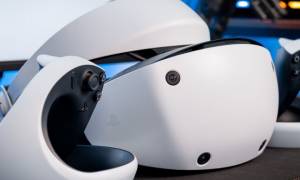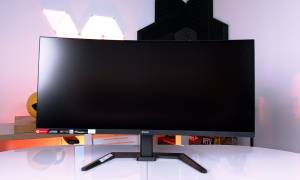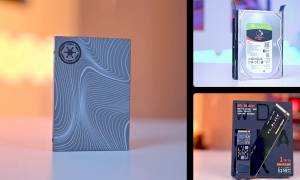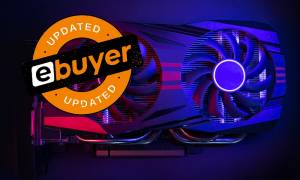When buying a gaming monitor in 2023, you’ll come across three main panel types: TN, IPS, and VA. But what are these, and how do they affect the gaming experience?
In this blog, we’re going to compare the strengths and weaknesses of each of these panel types and help you decide which one’s best for your gaming needs. Let’s get started.
TN – Fast Response Times, Poor Colour

In short, a TN – or ‘twisted nematic’ – panel is good for gaming… and not much else. Compared to the other panel types, TN’s key advantage is its low response times – or this at least used to be the case. A few years back, if you wanted the lowest response times, you would’ve had to go TN.
Nowadays, however, there are ‘Fast IPS’ panels out there that go toe-to-toe with even the best TN panels. The same can be said for refresh rates. TN once had the fastest refresh rates out of all the panel types, pushing up to 240Hz comfortably while IPS and VA were stuck at 144Hz for the most part. But now, it’s IPS that’s the fastest.
Older, More Affordable Technology
And for what you gain in speed on a TN panel, you lose in colour. TN is notorious for its narrow viewing angles and muted colour reproduction. So, TN is not ideal for colour-critical work, like video editing and content creation. Even if you’re a little bit off-axis, a TN panel will appear washed-out and show some nasty colour inversion too. A high-end TN monitor fares better in this regard, but it’ll still be weaker than an entry-level IPS monitor.
For those who want that competitive edge in esports titles and aren’t worried about how their game looks, then a TN monitor is a decent, if outdated, option. As IPS and VA panels have gotten so good nowadays, TN panels aren’t as necessary for gaming as they once were. Head on over to Ebuyer and you’ll see that IPS and VA monitors have clearly taken over the gaming monitor market, though TN monitor still tend to be the cheapest.
IPS – Great Colour Reproduction and Viewing Angles

It wasn’t too long ago that the fastest gaming monitors almost exclusively used TN panels, hitting high refresh rates with low response times to boot. But as of late, IPS – or ‘in-plane switching’ – technology has advanced considerably, to the point where modern ‘Fast IPS’ panels have caught right up to the speed of TN.
Now, you’ll find that the fastest gaming monitors on the market all leverage the latest IPS panels, boasting ridiculously fast refresh rates of up to 360Hz. There are even 500Hz IPS monitors in the pipeline for 2023. That’s over three times as fast as your standard 144Hz gaming monitor, though whether it’s needed is a question for a another video. Nonetheless, it’s clear that if you want the best when it comes to refresh rate, IPS is now the way to go.
Cheap IPS monitors might use last-generation panels with slow responses times, however, in which case you’d be better of with a TN for competitive gaming. Response times are an area where historically IPS lacked, but modern panels have improved upon to a huge degree. So, if you’re thinking of picking up an IPS monitor, make sure it’s got a ‘Fast IPS’ panel with decent response times to match its refresh rate.
Wider Colour Spaces
Even if you aren’t some pro-level gamer, IPS panels offer other advantages over TN and VA panels, most notably in their superior colour reproduction. These days most monitors can cover sRGB decently enough, the default colour space used by Windows and most content. If you’re after a monitor that’s more suitable for colour-critical work, one that can cover the wider colour spaces like DCI-P3, then IPS is your best choice. And with the majority of IPS panels delivering wide, 178-degree viewing angles, colour shifting and inversion is practically non-existent.
VA – Excellent Contrast Ratios, Sluggish Response Times

This leaves VA – or ‘vertical alignment’ – as the last panel type, and it’s a bit of a compromise between TN and IPS. Although the viewing angles of VA panels aren’t quite as good as an IPS, they’re certainly better than a TN. You’ll find that most VA monitors on the market are curved anyway, ensuring you’re getting an optimal viewing angle of your monitor. These curved VA panels also make a great choice if you’re putting together a multi-monitor gaming set-up.
And when it comes to contrast ratios, VA is by far the best out of all three panel types. While the very best IPS monitors currently top out at a 1,500:1 contrast ratio, with the average being more around the 1,000:1 mark, your run-of-the-mill VA monitor likely has at least a 3,000:1 contrast ratio. It’s not hard to find VA panels breaching a 4,000:1 or even a 5,000:1 contrast ratio, placing them well ahead of the other panel types. TN panels fare even worse than IPS panels, often with sub-1,000:1 contrast ratios.
Put simply, the higher the contrast ratio, the deeper the black levels. Not only does a higher contrast ratio improve image quality with deep shadows, it’s also important if you like to use you monitor in a dark environment. With weaker contrast ratios, IPS monitors can appear to ‘glow’ around the edges of their screens, and their blacks look more like a dark grey. This is distracting if you’re playing a horror game with the lights switched off, or watching a movie with black bars.
Black Smearing
While VA panels offer heightened immersion in cinematic AAA games with their rich contrast ratios, cheaper VA monitors are often held back by their sluggish response times. The end result are these trailing lines behind fast-moving objects, known as ‘black smearing’. You’ll notice it on the weapon model in a first-person shooter as you flick your mouse around, for instance. So, these cheaper VA monitors aren’t a great option if you mainly play twitchy, fast-paced games, which rules out a lot of popular esports titles.
If you want those high contrast ratios, without the low response times, there are high-end VA monitors that exhibit minimal black smearing. Though for some, any amount of black smearing is too much.
Which Panel is Best?
On the whole, we’d say VA panels are great for more casual users who do a little bit of everything on their monitor: gaming, content creation, watching movies. Though steer clear if you’re a competitive gamer. Black smearing on VA panels, on account of their slow response times, can make things messy when playing fast-paced games at high frame rates.
With the fastest refresh rates available today, response times right up there with TN panels, and vivid colours, IPS panels are great all-rounders for gaming. What’s more, IPS monitors can pull double-duty for content creation with fantastic colour reproduction, perfect if you’re looking to stream or make YouTube videos on the side. While they’re getting better, IPS contrast ratios leave a lot to be desired compared to even cheap VA panels.
A TN monitor will likely be the cheapest option available. With low response times, TN panels still offer a decent gaming experience, even if they don’t look all that great. If you can stretch your budget even a little bit, however, we’d recommend an IPS or VA monitor instead. They’ll give you a more well-rounded experience.
Gaming Monitors at Ebuyer
As you can see, there’s no one “best” panel type. TN, IPS, and VA all have their strengths and weaknesses. Which one you choose is all down to personal preference. So, have a think about what genres of games you play most, and prioritise based on that. Once you’ve evaluated what you use your monitor for most, the choice should become easier.
If you’re about to buy a gaming monitor, make sure to check out our Gaming Monitor Guide, Ultrawide Monitors for Gaming, and How to Set Up Gaming Monitor blogs.



























